 |
|||||||||||||||||||||||||||||||||||||||||||||||||||||||||||||||||||||||||||||||||||||||||||||||||||||||||||||||||||||||||||||
|
|
|||||||||||||||||||||||||||||||||||||||||||||||||||||||||||||||||||||||||||||||||||||||||||||||||||||||||||||||||||||||||||||
|
|||||||||||||||||||||||||||||||||||||||||||||||||||||||||||||||||||||||||||||||||||||||||||||||||||||||||||||||||||||||||||||
| Click HERE to see a video primer for solar energy. Click here to download the RealPlayer plugin. | |||||||||||||||||||||||||||||||||||||||||||||||||||||||||||||||||||||||||||||||||||||||||||||||||||||||||||||||||||||||||||||
| Solar/Hydrogen Aircraft... | |||||||||||||||||||||||||||||||||||||||||||||||||||||||||||||||||||||||||||||||||||||||||||||||||||||||||||||||||||||||||||||
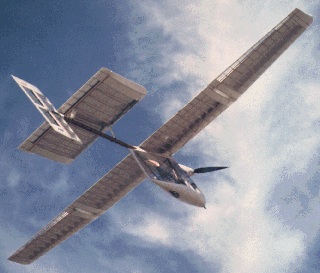 "Since the beginning of time man has dreamed of flying". How many times have you heard that one?! Too many? As overused as it may be, IT'S TRUE! I don't know about everyone else, but since the beginning of my time I've dreamed of it, and re-dreamed of it, and... There's only one major problem (other than it being too expensive for the average Joe), it's loud and polluting (alright, so that's three problems). To me, real flying is the kind birds do, silent, graceful, and natural (much like the solar powered Challenger at the left, except for the 'natural' part)! But since we weren't born with wings we need some sort of propulsion method, right? Enter the Wright Brothers and the dawn of the age of flight. Without going through a history lesson, let's just say that if it hadn't been for the gasoline piston engine they wouldn't have made that flight. To take a step further, had it not been for the jet engine the US may not have been able to maintain air superiority and consequently the cause of freedom (or at least the cause of oil) throughout the world for all these years. Certainly mass transcontinental travel would be nearly non-existent without the jet airliners of today. Laurels and accolades aside, it is also the most polluting form of transportation. With all the hooplah about auto pollution, the aviation industry had been sneaking by relatively unnoticed. Zero emission mandates for cars in California abounded until one day someone mentioned that a jet airliner produces about as much air pollution as 1 million cars on an "Since the beginning of time man has dreamed of flying". How many times have you heard that one?! Too many? As overused as it may be, IT'S TRUE! I don't know about everyone else, but since the beginning of my time I've dreamed of it, and re-dreamed of it, and... There's only one major problem (other than it being too expensive for the average Joe), it's loud and polluting (alright, so that's three problems). To me, real flying is the kind birds do, silent, graceful, and natural (much like the solar powered Challenger at the left, except for the 'natural' part)! But since we weren't born with wings we need some sort of propulsion method, right? Enter the Wright Brothers and the dawn of the age of flight. Without going through a history lesson, let's just say that if it hadn't been for the gasoline piston engine they wouldn't have made that flight. To take a step further, had it not been for the jet engine the US may not have been able to maintain air superiority and consequently the cause of freedom (or at least the cause of oil) throughout the world for all these years. Certainly mass transcontinental travel would be nearly non-existent without the jet airliners of today. Laurels and accolades aside, it is also the most polluting form of transportation. With all the hooplah about auto pollution, the aviation industry had been sneaking by relatively unnoticed. Zero emission mandates for cars in California abounded until one day someone mentioned that a jet airliner produces about as much air pollution as 1 million cars on an average flight! What to do, what to do?! Society as we know it would cease to function without air travel, but continuing with the status quo would eventually kill off everyone from toxic air, and then society would certainly cease to function. It was then that the DOE asked NASA to look into ways to make air travel more eco-friendly. As it turns out, not only NASA, but many other companies worldwide had done research into hydrogen powered aircraft (artist's conception at right) as early as the 1950's. average flight! What to do, what to do?! Society as we know it would cease to function without air travel, but continuing with the status quo would eventually kill off everyone from toxic air, and then society would certainly cease to function. It was then that the DOE asked NASA to look into ways to make air travel more eco-friendly. As it turns out, not only NASA, but many other companies worldwide had done research into hydrogen powered aircraft (artist's conception at right) as early as the 1950's.
Can hydrogen really power a jet aircraft?... Hydrogen has been used as rocket fuel since the dawn of space flight. From early research it was clear that jet engines could also be altered to run on liquid hydrogen. Although they're still just as loud, at least they don't spew out toxic gases. Right? Well, not completely. It turns out that the high temperatures inherent in jet-type combustion cause the production of copius amounts of nitrogen-oxides. You'll remember from our hydrogen combustion page that, in hydrogen burning automobiles, various techniques are employed to avoid the high temperatures (above 4000 degrees Celsius). This isn't as easy with a jet engine, but it's not impossible. Already researchers have found ways through fuel injection technology to help the NO2 problem and So what about electric powered aircraft?... Electric aircraft? Are you crazy?! How could an aircraft possibly be powered by electricity? I was hoping you'd ask! If electricity can drive automobiles and large buses then certainly it can power an aircraft.
The return of the Air Ship?... Is the Hindenburg coming back like bell bottoms? Maybe so! The wonderful thing about air ships, dirigibles, blimps, whatever you want to call them, is that they require very little in the way of propulsion energy to move them. The lifting gas does most of the work. The video link about the Hindenburg on the top of this page describes in detail how hydrogen was not to blame for the accident at all, nor was it responsible for any of the deaths. In reality, post accident studies revealed the true culprit was the aluminum-oxide based paint with which the entire skin of the blimp was painted. The paint contained a chemical composition similar to solid rocket booster fuel. As the air ship traveled through the air it accumulated a sizeable static electric charge on the ship's skin. When the ground crew caught hold of the guide ropes it caused the ship to become electrically grounded, which then caused a large spark on the skin of the craft. This spark ignited the paint and caused the craft to burn rapidly. Of the 43 people that died in the incident, 40 died because they jumped off the craft and 3 died from diesel fuel burns (the diesel fuel continued to burn on the ground for 15 hours after the accident!). When the hydrogen burned, its flame went straight up into the air, away from the people, and was completely consumed in less than 3 minutes! Upon further study it was found that of all dirigibles, the ones using hydrogen as a lifting gas had a better safety record than the ones using helium. All that aside, blimps are perfectly suited for electric propulsion! Since weight is less of a problem than on airplanes, existing blimps could be easily retrofitted with electric motors. Even better, the large amount of surface area lends itself well to solar power. Imagine the skin covered with thin-film solar cells. With this configuration the blimp could conceivably remain up indefinitely and never lose power. Has anyone done this? Well, yes, but not officially. I had the pleasure of interviewing Michael Hackleman, author of the famous book The New Electric Vehicles: The Clean and Quiet Revolution after listening to him speak at the Midwest Renewable Energy Fair in Wisconsin. He was very careful not to reveal too many details but he and a team have built a two-person solar-electric air ship that apparently resembles a flying saucer. He says that the lifting gas is hydrogen which is generated on the ground by solar panels driving a water electrolysis unit. On-board the craft, they utilize a parabolic reflective dish which focuses sunlight onto a relatively small plate of Gallium Arsenide solar cells. He said GaAs solar cells don't have the efficiency losses of silicon cells when heated, which makes them perfect for this application. He claims he's able to So what about fuel cells?... FUEL CELLS?! Indeed, fuel cells ARE the future of propeller-driven aircraft. With all the recent buzz over the promise of fuel cells, and the recent push by NASA and the EPA to tackle polluting aircraft, it's no surprise that on July 24, 2001 it was announced that a company, Foundation for Advancing Science and Technology Education (FASTec), headed by James P. Dunn is planning on being the first to fly a fuel cell powered airplane. Not the gangly looking ones like at the top of this page, but a real passenger-carrying aiplane. To be exact, a converted French |
|||||||||||||||||||||||||||||||||||||||||||||||||||||||||||||||||||||||||||||||||||||||||||||||||||||||||||||||||||||||||||||
| Click HERE to see a video on the REAL reason the Hindenburg crashed (IT WASN'T HYDROGEN!). Get RealPlayer here. | |||||||||||||||||||||||||||||||||||||||||||||||||||||||||||||||||||||||||||||||||||||||||||||||||||||||||||||||||||||||||||||
|
|
|||||||||||||||||||||||||||||||||||||||||||||||||||||||||||||||||||||||||||||||||||||||||||||||||||||||||||||||||||||||||||||
|
|
|||||||||||||||||||||||||||||||||||||||||||||||||||||||||||||||||||||||||||||||||||||||||||||||||||||||||||||||||||||||||||||

Learn everything there is to know about electric vehicles in Michael Hackleman's book "The New Electric Vehicles, A Clean and Quiet Revolution". This is the most complete and comprehensive book on electric vehicles SunWater has ever read! An excellent source for technical "how to convert" as well as a wealth of facts, stats, and knowledge on every field related to electric vehicles. A must have! Click here to get it at Amazon.com. |
|||||||||||||||||||||||||||||||||||||||||||||||||||||||||||||||||||||||||||||||||||||||||||||||||||||||||||||||||||||||||||||
|
|
|||||||||||||||||||||||||||||||||||||||||||||||||||||||||||||||||||||||||||||||||||||||||||||||||||||||||||||||||||||||||||||

This is a must have for anyone serious about using hydrogen as a fuel! An absolute wealth of information on hydrogen production, combustion, fuel cells, storage techniques, etc.. Case study after case study. SunWater has read it and re-read it... definitely worth its weight in oil! Click here to buy it now from Amazon.com. |
|||||||||||||||||||||||||||||||||||||||||||||||||||||||||||||||||||||||||||||||||||||||||||||||||||||||||||||||||||||||||||||
|
|
|||||||||||||||||||||||||||||||||||||||||||||||||||||||||||||||||||||||||||||||||||||||||||||||||||||||||||||||||||||||||||||
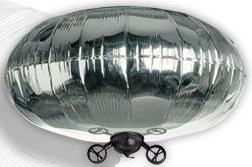
Have you ever seen a UFO? Now you have! These are perhaps the safest, easiest and least expensive radio-controlled indoor flying ships available. That's right, INDOOR FLYING SHIPS! Explore the alien landscape in your home. Or have up to 4 of them at once testing your aerial combat skills against your friends'. Explore the future of eco-aviation! The sky's the limit! Also RF video cam ready for remote viewing and UAV testing. Click here to buy it now from Plantraco.com. |
|||||||||||||||||||||||||||||||||||||||||||||||||||||||||||||||||||||||||||||||||||||||||||||||||||||||||||||||||||||||||||||
|
|
|||||||||||||||||||||||||||||||||||||||||||||||||||||||||||||||||||||||||||||||||||||||||||||||||||||||||||||||||||||||||||||
|
The Quick 'n Clean on Solar/Hydrogen Aircraft...
|
|||||||||||||||||||||||||||||||||||||||||||||||||||||||||||||||||||||||||||||||||||||||||||||||||||||||||||||||||||||||||||||
|
|||||||||||||||||||||||||||||||||||||||||||||||||||||||||||||||||||||||||||||||||||||||||||||||||||||||||||||||||||||||||||||
|
|||||||||||||||||||||||||||||||||||||||||||||||||||||||||||||||||||||||||||||||||||||||||||||||||||||||||||||||||||||||||||||
|
|
|||||||||||||||||||||||||||||||||||||||||||||||||||||||||||||||||||||||||||||||||||||||||||||||||||||||||||||||||||||||||||||
|
Website design by JClaw Enterprises
|
|||||||||||||||||||||||||||||||||||||||||||||||||||||||||||||||||||||||||||||||||||||||||||||||||||||||||||||||||||||||||||||
|
|||||||||||||||||||||||||||||||||||||||||||||||||||||||||||||||||||||||||||||||||||||||||||||||||||||||||||||||||||||||||||||
|
This page copyright 2001 by JClaw Enterprises. All trademarks remain the property of their respective owners.
|
|||||||||||||||||||||||||||||||||||||||||||||||||||||||||||||||||||||||||||||||||||||||||||||||||||||||||||||||||||||||||||||
 greatly reduce it's production. Unforturnately, it doesn't seem that NO2 production is completely avoidable. Even so, emissions are still only 20% of that of kerosene burning engines. Other than that, the only other emission is water vapor. At ground level this isn't a problem, but at high altitudes (above 10km) water vapor is a greenhouse gas. This may seem alarming at first, what with all the talk about CO2 and global warming, but on second glance we discover that hydrogen powered jets could easily be re-routed to altitudes lower than 10km. (Hydrogen powered craft produce about 2.6 times the amount of water vapor than a kerosene jet, except the kerosene has a whole bunch of carbon and sulphur added in for fun.) So, with the NO2 problem solved, hydrogen aircraft are indeed the eco-friendly solution we've been looking for, right? Not so fast. Turns out that there are a few technical problems that must be solved first. Principle among those is the large volume that hydrogen occupies. Even as a liquid, hydrogen occupies almost 3 times the volume of kerosene. The upside to this is that
greatly reduce it's production. Unforturnately, it doesn't seem that NO2 production is completely avoidable. Even so, emissions are still only 20% of that of kerosene burning engines. Other than that, the only other emission is water vapor. At ground level this isn't a problem, but at high altitudes (above 10km) water vapor is a greenhouse gas. This may seem alarming at first, what with all the talk about CO2 and global warming, but on second glance we discover that hydrogen powered jets could easily be re-routed to altitudes lower than 10km. (Hydrogen powered craft produce about 2.6 times the amount of water vapor than a kerosene jet, except the kerosene has a whole bunch of carbon and sulphur added in for fun.) So, with the NO2 problem solved, hydrogen aircraft are indeed the eco-friendly solution we've been looking for, right? Not so fast. Turns out that there are a few technical problems that must be solved first. Principle among those is the large volume that hydrogen occupies. Even as a liquid, hydrogen occupies almost 3 times the volume of kerosene. The upside to this is that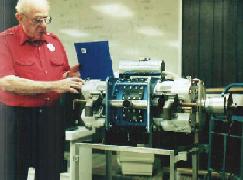 hydrogen is also much lighter and has 3 times the energy density of kerosene. These two things together make for a lighter aircraft that can carry greater payload, or extra fuel to fly longer distances, or use smaller engines to reduce noise, but that also have very large fuel tanks (see the odd looking Cryoplane above left). Jet engines aren't the only types of aircraft engines looking to use hydrogen. At the right you can see a piston type aircraft engine called the Larsen Radax (Radial and Axial) engine. It was designed from the ground up to run on hydrogen. It uses what's termed the 'Larsen cycle' which, unlike traditional 2 and 4 stroke engines, is such that every stroke is a power stroke. It has 8 cylinders, 4 opposing pairs on each end, and develops 561 hp @ 2000 rpm while only weighing 250 lbs! All that and it's zero emissions too! It operates on the stratified charge principle which throttles via direct fuel injection and a free-breathing air intake. The geometry is such that all 8 cylinders fire 3 times on each shaft revolution (every 30 degrees) which makes for super smooth and silent operation with virtually no vibration (also due to the use of cam rollers on the pistons). This is an amazing engine and anyone wanting further information may contact the
hydrogen is also much lighter and has 3 times the energy density of kerosene. These two things together make for a lighter aircraft that can carry greater payload, or extra fuel to fly longer distances, or use smaller engines to reduce noise, but that also have very large fuel tanks (see the odd looking Cryoplane above left). Jet engines aren't the only types of aircraft engines looking to use hydrogen. At the right you can see a piston type aircraft engine called the Larsen Radax (Radial and Axial) engine. It was designed from the ground up to run on hydrogen. It uses what's termed the 'Larsen cycle' which, unlike traditional 2 and 4 stroke engines, is such that every stroke is a power stroke. It has 8 cylinders, 4 opposing pairs on each end, and develops 561 hp @ 2000 rpm while only weighing 250 lbs! All that and it's zero emissions too! It operates on the stratified charge principle which throttles via direct fuel injection and a free-breathing air intake. The geometry is such that all 8 cylinders fire 3 times on each shaft revolution (every 30 degrees) which makes for super smooth and silent operation with virtually no vibration (also due to the use of cam rollers on the pistons). This is an amazing engine and anyone wanting further information may contact the  This is a realm which is diametrically opposed to combustion-based aircraft. An electric aircraft uses an electric motor to turn the propeller and is powered by on-board electrical energy storage such as batteries or solar panels. Electric aircraft have been around for a fairly short time. NASA has been the biggest player in this arena, but the world's record for the longest continuous human-piloted electric-powered flight was held by a non-NASA-ite. On July 7, 1981 Steve Ptacek flew a solar-electric aircraft across the English Channel from Pointoise, France to Kent, England. The plane, the Solar Challenger (at left)
This is a realm which is diametrically opposed to combustion-based aircraft. An electric aircraft uses an electric motor to turn the propeller and is powered by on-board electrical energy storage such as batteries or solar panels. Electric aircraft have been around for a fairly short time. NASA has been the biggest player in this arena, but the world's record for the longest continuous human-piloted electric-powered flight was held by a non-NASA-ite. On July 7, 1981 Steve Ptacek flew a solar-electric aircraft across the English Channel from Pointoise, France to Kent, England. The plane, the Solar Challenger (at left) , was sponsored by Dupont and designed with the help of a Mr. Boucher of
, was sponsored by Dupont and designed with the help of a Mr. Boucher of 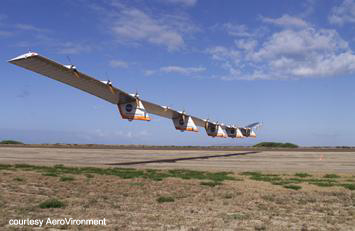 you, the challenge in designing any aircraft is to maximize the power-to-weight ratio. The problem with electric aircraft is the same problem with electric cars, the batteries. The motor itself is really no problem as there are many electric motors light enough and powerful enough to power an airplane at typical airplane speeds. The problem is that the batteries have a very low energy density, specific energy or Whr/kg, and in some cases a low specific power too (W/kg). This means the batteries are very heavy and don't store enough energy to power the motor for very long. The partial fix for this has been to use fewer batteries, but ones that have a high specific power (can deliver high currents). This helps the weight problem but makes for very short flights. The other method has been to use extremely light, but strong, materials for the fuselage - such as carbon fibers. SunWater designed, built, and flew a radio controlled electric aircraft (above left) that was built out of carbon fiber rods and powered by Ni-Cd batteries. The plane met all of the design requirements except one, good aerodynamics. This made for flight times of about 5 minutes. Designs with lower drag coefficients achieve much better results. The radio-controlled aircraft market has all but perfected small electric aircraft nowadays. With
you, the challenge in designing any aircraft is to maximize the power-to-weight ratio. The problem with electric aircraft is the same problem with electric cars, the batteries. The motor itself is really no problem as there are many electric motors light enough and powerful enough to power an airplane at typical airplane speeds. The problem is that the batteries have a very low energy density, specific energy or Whr/kg, and in some cases a low specific power too (W/kg). This means the batteries are very heavy and don't store enough energy to power the motor for very long. The partial fix for this has been to use fewer batteries, but ones that have a high specific power (can deliver high currents). This helps the weight problem but makes for very short flights. The other method has been to use extremely light, but strong, materials for the fuselage - such as carbon fibers. SunWater designed, built, and flew a radio controlled electric aircraft (above left) that was built out of carbon fiber rods and powered by Ni-Cd batteries. The plane met all of the design requirements except one, good aerodynamics. This made for flight times of about 5 minutes. Designs with lower drag coefficients achieve much better results. The radio-controlled aircraft market has all but perfected small electric aircraft nowadays. With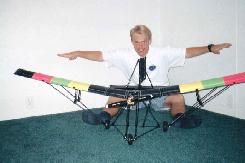 excellent motors and high capacity batteries these aircraft often achieve greater flight times than their noisy, dirty gasoline counterparts! Not only that, but they are also capable of flying faster in many instances. All this and they're quiet and clean too. Please see a small lineup of commonly available electic RC aircraft below. From jets to flying platforms to flying saucers (see above right), these amazing little aircraft demonstrate the future of eco-friendly flight. You might wonder why we don't see their full-sized, piloted, passenger carrying counterparts quietly flying around our blue skies? It turns out that the batteries don't scale up as easily as the rest of the aircraft does. Making larger motors is relatively easy, but making bigger batteries is another problem altogether. Only recently have high capacity batteries become available in big sizes, mostly thanks to the push from the electric and hybrid car industries. But certainly batteries aren't our only hope! Read on...
excellent motors and high capacity batteries these aircraft often achieve greater flight times than their noisy, dirty gasoline counterparts! Not only that, but they are also capable of flying faster in many instances. All this and they're quiet and clean too. Please see a small lineup of commonly available electic RC aircraft below. From jets to flying platforms to flying saucers (see above right), these amazing little aircraft demonstrate the future of eco-friendly flight. You might wonder why we don't see their full-sized, piloted, passenger carrying counterparts quietly flying around our blue skies? It turns out that the batteries don't scale up as easily as the rest of the aircraft does. Making larger motors is relatively easy, but making bigger batteries is another problem altogether. Only recently have high capacity batteries become available in big sizes, mostly thanks to the push from the electric and hybrid car industries. But certainly batteries aren't our only hope! Read on... 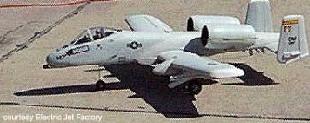
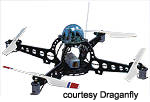
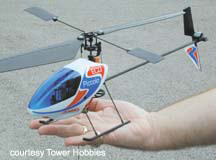
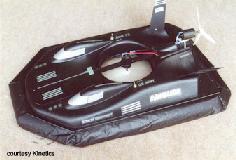
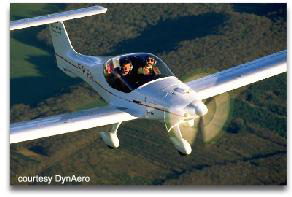 DynAero Lafayette III (see right). Why choose this aircraft? Perhaps because it's made out of carbon-fiber construction or maybe it's because it looks really cool!? Fuel cells have become so small, light, and energy dense that they're the perfect solution to the battery problem. With refueling instead of recharging, these craft will have all of the benefits of modern gasoline powered craft, but with water vapor instead of toxic gases and a quiet whir in place of the deafening roar. The company plans on executing the project in stages. First they'll power the plane off lithium-ion batteries which have the highest energy density of all batteries. Next they'll use a hybrid combination of Li-Ion batteries and fuel cells. Finally, they'll replace the batteries completely with fuel cells. They expect to have a range of 500 to 800 miles between hydrogen fillups. Although fuel cells will probably never power large jet aircraft, they won't need to since they can use hydrogen through combustion. The bottom line is: the technology to have environmentally friendly air travel is here today. It's true that further development will need to be done to perfect these news types of aircraft to the level their petroleum fueled counterparts are today, but the important thing to remember is that the transition needs to begin now!
DynAero Lafayette III (see right). Why choose this aircraft? Perhaps because it's made out of carbon-fiber construction or maybe it's because it looks really cool!? Fuel cells have become so small, light, and energy dense that they're the perfect solution to the battery problem. With refueling instead of recharging, these craft will have all of the benefits of modern gasoline powered craft, but with water vapor instead of toxic gases and a quiet whir in place of the deafening roar. The company plans on executing the project in stages. First they'll power the plane off lithium-ion batteries which have the highest energy density of all batteries. Next they'll use a hybrid combination of Li-Ion batteries and fuel cells. Finally, they'll replace the batteries completely with fuel cells. They expect to have a range of 500 to 800 miles between hydrogen fillups. Although fuel cells will probably never power large jet aircraft, they won't need to since they can use hydrogen through combustion. The bottom line is: the technology to have environmentally friendly air travel is here today. It's true that further development will need to be done to perfect these news types of aircraft to the level their petroleum fueled counterparts are today, but the important thing to remember is that the transition needs to begin now!